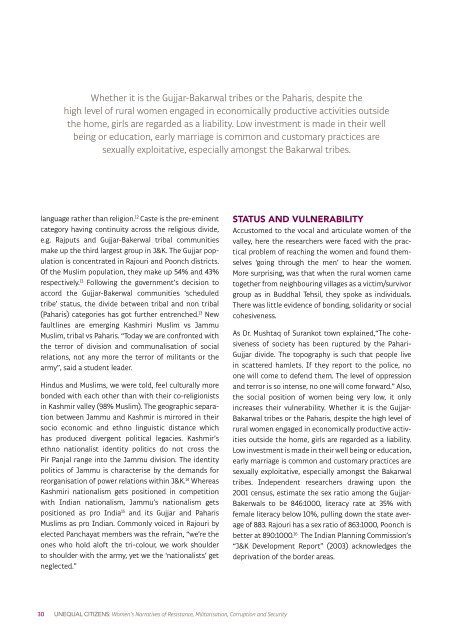CC_India
CC_India
CC_India
You also want an ePaper? Increase the reach of your titles
YUMPU automatically turns print PDFs into web optimized ePapers that Google loves.
Whether it is the Gujjar-Bakarwal tribes or the Paharis, despite the<br />
high level of rural women engaged in economically productive activities outside<br />
the home, girls are regarded as a liability. Low investment is made in their well<br />
being or education, early marriage is common and customary practices are<br />
sexually exploitative, especially amongst the Bakarwal tribes.<br />
language rather than religion. 12 Caste is the pre-eminent<br />
category having continuity across the religious divide,<br />
e.g. Rajputs and Gujjar-Bakerwal tribal communities<br />
make up the third largest group in J&K. The Gujjar population<br />
is concentrated in Rajouri and Poonch districts.<br />
Of the Muslim population, they make up 54% and 43%<br />
respectively. 13 Following the government’s decision to<br />
accord the Gujjar-Bakerwal communities ‘scheduled<br />
tribe’ status, the divide between tribal and non tribal<br />
(Paharis) categories has got further entrenched. 13 New<br />
faultlines are emerging Kashmiri Muslim vs Jammu<br />
Muslim, tribal vs Paharis. “Today we are confronted with<br />
the terror of division and communalisation of social<br />
relations, not any more the terror of militants or the<br />
army”, said a student leader.<br />
Hindus and Muslims, we were told, feel culturally more<br />
bonded with each other than with their co-religionists<br />
in Kashmir valley (98% Muslim). The geographic separation<br />
between Jammu and Kashmir is mirrored in their<br />
socio economic and ethno linguistic distance which<br />
has produced divergent political legacies. Kashmir’s<br />
ethno nationalist identity politics do not cross the<br />
Pir Panjal range into the Jammu division. The identity<br />
politics of Jammu is characterise by the demands for<br />
reorganisation of power relations within J&K. 14 Whereas<br />
Kashmiri nationalism gets positioned in competition<br />
with <strong>India</strong>n nationalism, Jammu’s nationalism gets<br />
positioned as pro <strong>India</strong> 15 and its Gujjar and Paharis<br />
Muslims as pro <strong>India</strong>n. Commonly voiced in Rajouri by<br />
elected Panchayat members was the refrain, “we’re the<br />
ones who hold aloft the tri-colour, we work shoulder<br />
to shoulder with the army, yet we the ‘nationalists’ get<br />
neglected.”<br />
STATUS AND VULNERABILITY<br />
Accustomed to the vocal and articulate women of the<br />
valley, here the researchers were faced with the practical<br />
problem of reaching the women and found themselves<br />
‘going through the men’ to hear the women.<br />
More surprising, was that when the rural women came<br />
together from neighbouring villages as a victim/survivor<br />
group as in Buddhal Tehsil, they spoke as individuals.<br />
There was little evidence of bonding, solidarity or social<br />
cohesiveness.<br />
As Dr. Mushtaq of Surankot town explained,“The cohesiveness<br />
of society has been ruptured by the Pahari–<br />
Gujjar divide. The topography is such that people live<br />
in scattered hamlets. If they report to the police, no<br />
one will come to defend them. The level of oppression<br />
and terror is so intense, no one will come forward.” Also,<br />
the social position of women being very low, it only<br />
increases their vulnerability. Whether it is the Gujjar-<br />
Bakarwal tribes or the Paharis, despite the high level of<br />
rural women engaged in economically productive activities<br />
outside the home, girls are regarded as a liability.<br />
Low investment is made in their well being or education,<br />
early marriage is common and customary practices are<br />
sexually exploitative, especially amongst the Bakarwal<br />
tribes. Independent researchers drawing upon the<br />
2001 census, estimate the sex ratio among the Gujjar-<br />
Bakerwals to be 846:1000, literacy rate at 35% with<br />
female literacy below 10%, pulling down the state average<br />
of 883. Rajouri has a sex ratio of 863:1000, Poonch is<br />
better at 890:1000. 16 The <strong>India</strong>n Planning Commission’s<br />
“J&K Development Report” (2003) acknowledges the<br />
deprivation of the border areas.<br />
30 UNEQUAL CITIZENS: Women’s Narratives of Resistance, Militarisation, Corruption and Security


